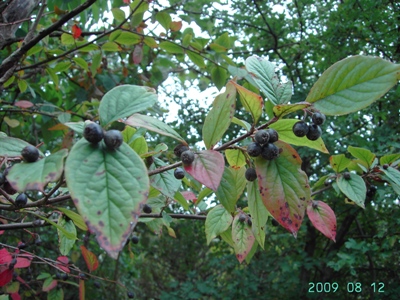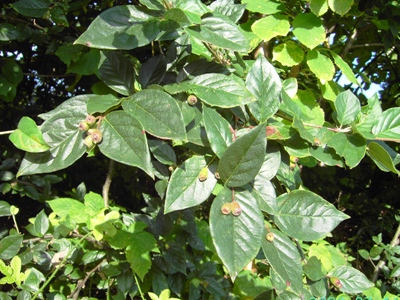Cotoneaster villosulus (Rehder & E.H. Wilson) Flinck & B. Hylmö, Bot. Not. 115: 383, 1962.
Synonym: Cotoneaster acutifolius Turczaninov var. villosulus Rehder & E.H. Wilson.
Section Acutifolii, series Acutifolii
Origin: China (Hubei).
Presence in western Europe: Naturalized in Germany (invasive according to John & Frank 2008) and Great Britain (Stace 2010). Also known from Scandinavia (Karlsson 2002).
Cultivation in Belgium and the Netherlands: unknown, perhaps confused with the commonly cultivated Cotoneaster lucidus Schlechtendal or (the less common) C. acutifolius Turczaninov (De Koning & van den Broek 2009).
Comparative taxonomy: Species included in a broadly circumscribed Cotoneaster ambiguus Rehder & E.H. Wilson by Dickoré & Kasperek (2010). Lingdi & Brach (2003) apply a still different taxonomic framework for Flora of China: they subsume nearly all species of series Acutifolii as varieties under Cotoneaster acutifolius.
Illustrations: Grevtsova (1999), John & Frank (2008), Fryer & Hylmö (2009), Stace (2010).
Cotoneaster villosulus seems to be a rare species in Belgium, in cultivation as well as in the wild. It is known from railway sidings in Roeselare since at least 1997. For a long time it was restricted to one or two bushes on one side of the railway track (that eventually disappeared after road works). However, it managed to spread to the other side of the track where it now is fully naturalized. In 2011 a single young individual was discovered ca. 1 km further north, on the margin of a Picea-plantation. It most likely originates from its known population. Cotoneaster villosulus was furthermore recorded in 2009 in scrub in coastal dunes in Koksijde (Oostduinkerke, Plaatsduinen; two bushes).
In Belgium Cotoneaster villosulus usually seems to grow on dry, often stony substrate in half-shade. So far, it has been recorded on talus slopes of railway tracks and in scrub in coastal dunes. In Germany it is more often found in open or even dense woodland (John & Frank 2008, Dickoré & Kasperek 2010)
Cotoneaster villosulus is immediately distinguished from nearly all other Belgian representatives of Cotoneaster by its black berries (when mature), its deciduous foliage and the flowers with erecto-patent petals. However, the few other species with similar characteristics are hard to tell apart (in Belgium: Cotoneaster ambiguus Rehder & E.H. Wilson and C. moupinensis Franchet). All belong to the species spectrum that links Cotoneaster acutifolius and C. moupinensis (Dickoré & Kasperek 2010). Cotoneaster moupinensis (which like C. rehderi belongs to Series Bullati) is distinguished by its bullate, larger leaves (65-130 mm long), (4-)5 nutlets per berry and multi-flowered inflorescence with 15-50 flowers (vs. leaves 50-65 mm long with very slightly impressed veins, 2(-3) nutlets per berry and few-flowered inflorescences with 3-5 flowers in C. villosulus). Cotoneaster ambiguus is much more closely related (and treated as conspecific by Dickoré & Kasperek 2010). It has narrower leaves (up to 30 mm wide), smaller fruits (7-9 mm) and a less densely hairy (not tomentose) hypanthium. The taxonomy of this group obviously requires further research.
 |
 |
|
|
|
Literature
De Koning J. & van Den Broek (2009) Nederlandse Dendrologie (14th ed.). K.N.N.V.: 547 p.
Dickoré W.B. & Kasperek G. (2010) Species of Cotoneaster (Rosaceae, Maloideae) indigenous to, naturalising or commonly cultivated in Central Europe. Willdenowia 40: 13-45 [available online at: http://user.uni-frankfurt.de/~kasperek/papers/dickore_kasperek_2010.pdf].
Fryer J. & Hylmö B. (2009) Cotoneasters. A comprehensive guide to shrubs for flowers, fruit, and foliage. Timber Press, Portland-London: 344 p.
Grevtsova A.T. (1999) Atlas Cotoneasters. Cotoneaster (Medic.) Bauhin. Kiev, House Orchard, Truck-Garden: 372 p.
John H. & Frank D. (2008) Verwilderte Cotoneaster-Arten in Halle (Saale) und Umgebung. Mitt. Florist. Kart. Sachsen-Anhalt 13: 3-28 [available online at: http://bv-st.de/images/Flo-Kart_2008_003-028_John_Frank.pdf ].
Karlsson T. (2002) Nyheter i den svenska kärlväxtfloran II. Korsblommiga–flockblommiga. Svensk Botanisk Tidskrift 96: 186-206. [available online at: http://sbf.c.se/www/pdf/96(3-4)/Karlsson.pdf]
Lingdi L. & Brach A.R. (2003) Cotoneaster. In: Wu Z.Y. & Raven P.H. (eds.), Flora of China, vol. 9. Science Press, Beijing & Missouri Botanical Garden Press, St. Louis: 85-108 [available online at: http://flora.huh.harvard.edu/china/PDF/PDF09/Cotoneaster.PDF].
Stace C. (2010) New Flora of the British Isles, 3th ed.: XXXII + 1232 p. Cambridge University Press.

